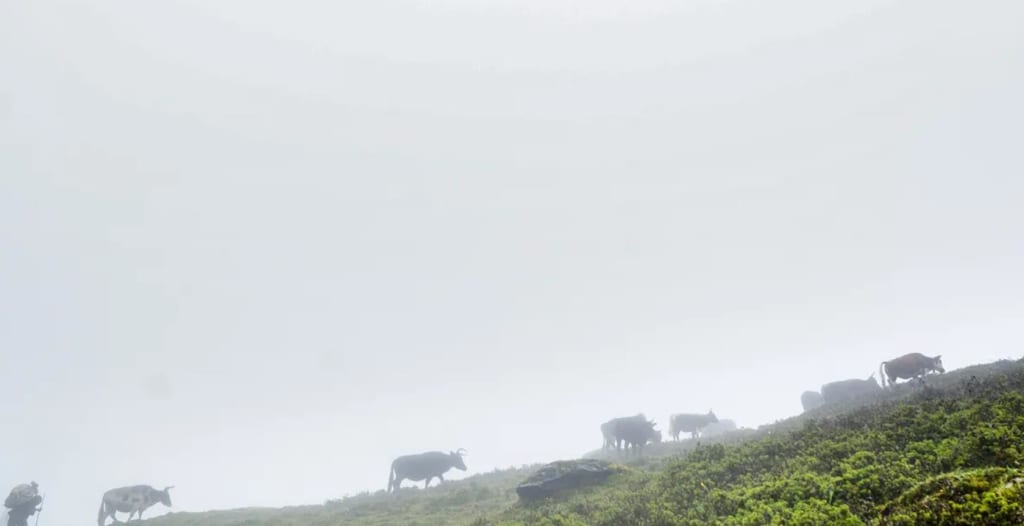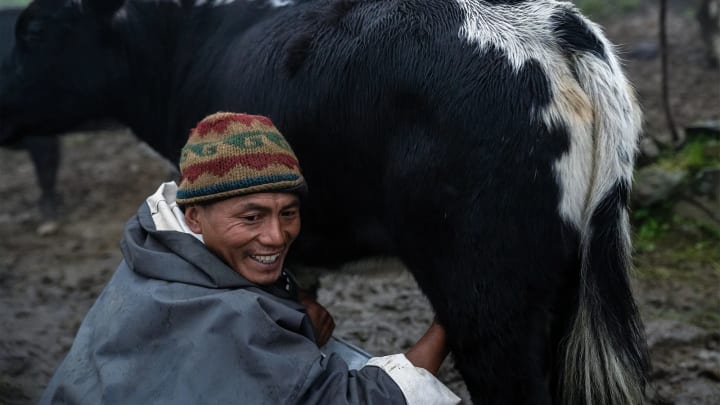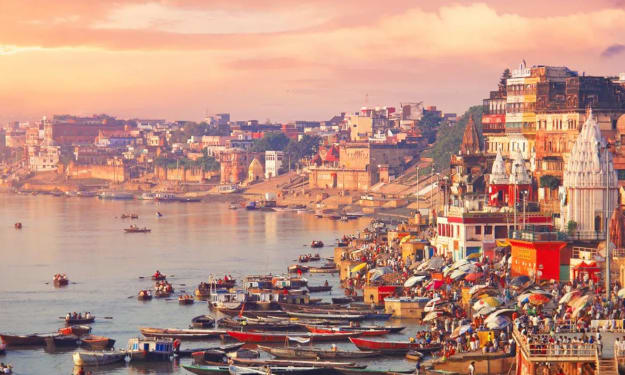Chhurpi: The world's hardest cheese?
Created thousands of years ago in the remote reaches of the Himalayas, chhurpi can be eaten for up to 20 years.

Enveloped in a thick veil of grey mist, Nepal's remote Himalayan village of Parvathy Kund was nearly deserted. One of the few people in sight was an old woman sitting in the doorway of a wooden house, who flashed a welcoming, toothless smile at my friend and I. "Would you like to eat some chhurpi?" my friend asked the woman, having just bought a few kilograms of the local cheese from a factory opposite her home.
"I can't finish chewing that, even in a whole year!" she responded with a hearty laugh. After all, chhurpi is considered to be the hardest cheese in the world.
A traditional product prepared by pastoralists in the highlands of the Eastern Himalayas, chhurpi is a protein-rich cheese with a smoky flavour and hard consistency that gradually becomes chewier the longer you gnaw at it. It is made from the milk produced by chauri – a cross between a male yak and a female cow – and it's a favourite snack in pockets of eastern India and much of Nepal and Bhutan. People often chew on small cubes of the stuff for hours on end, like a rock-hard bubble gum that slowly softens with time and saliva. The solid snack's uniquely hard texture is a consequence of the high-altitude climate and the harsh lifestyle of the Himalayas.
The previous day, at an altitude of 4,000m, high above the village of Parvathy Kund, a chhurpi maker from the nearby village of Gatlang named Pasang Darche Tamang patiently churned chauri milk in a makeshift tent perched at the end of a precipice. Fog rolled into the tent's opening from the green valley below as relentless rain pelted its blue canvas. Smoke from the wooden fire filled the tent, where dried pieces of meat hung over the boiling milk cauldron to extend its shelf life in the harsh, Himalayan altitudes. He had been turning the handle of the machine that separates milk from cream without a break for more than three hours.
"It needs strength," Tamang said. "Without force, the machine won't even turn."

Every morning, Tamang wakes up at 04:00 to start milking his 25 chauris to make chhurpi. Several yak herders from nearby pastures visit Tamang's tent to deposit fresh milk from their own chauris throughout the day. Including the milk from his herd, Tamang collects more than 300 litres per day, which has to be turned into chhurpi immediately before it goes bad.
Living on the roof of the world with limited trade opportunities and arable land, animal husbandry has been the mainstay of many Himalayan communities for centuries. According to Mukta Singh Lama Tamang (no relation to Pasang), an anthropologist at Tribhuvan University in Kathmandu, dairy has been an inextricable part of Himalayan culture and livelihood throughout history. Mukta says chhurpi was concocted thousands of years ago out of the need to do something productive with the extra milk that can't be consumed or sold anymore.
One of the unique features of chhurpi is that it has a very low moisture content. This makes it very hard to bite into, but it also helps the cheese stay edible for months, or even years, when fermented for six to 12 months, dried and stored properly in animal skin. In the remote Himalayan highlands, this has made chhurpi particularly desirable, as yak herders have been able to rely on it during long journeys, as well as transport and sell it at markets. Since both fermentation and dehydration extends a food's shelf life, chhurpi is particularly well suited to high altitudes where there are few fresh supplies and other protein-rich foods. Soft chhurpi, before it is smoked and dried, is often used in curries, soups and pickled along with cucumber and radish, while the hard variety is chewed by itself as a snack.

The previous night, a few hundred meters below his cheese-making tent, three young calves were packed inside Pasang's small stone shelter while his 25 chauris were tied up outside. Pasang's father, Finjo, boiled chauri milk on an open fire, and once it was ready, he, Pasang and Pasang's uncle slurped on the hot milk with great pleasure as the flickering flame illuminated the hardened lines on their sunburnt faces. The three men had been living in the alpine grasslands for weeks, grazing the chauris in the verdant pastures and collecting fresh milk that would be turned into chhurpi daily. Their lives revolved entirely around their animals.
"We're grateful to have all the chauris and be able to make chhurpi because we are illiterate and this is the only way [we] can sustain ourselves. This is what we know, how to make chhurpi, and this is how we will survive. Not only do we get to carry on our ancient culture, but this also helps us economically," said Pasang.
As the rain outside gathered force, Finjo recounted his memories of the past: "There was no road, and we had no provision to get essential supplies. We only had milk and nothing else. And we used to prepare whatever we could from it, like chhurpi and butter, and trade them in villages nearby in exchange for rice, grain, salt and oil. If we needed money, we'd go to a bigger market like Trishuli to get vegetables, which we would then bring back to our village and sell for money. It was tough."

Even as roads have slowly cut through the mountainous valleys here, life is still difficult for pastoralists like Pasang. He has been rearing chauris for roughly 20 years, and has spent a considerable amount of his life away from family, staying high up in the pastures with his livestock for several months each year.
"There is a special kind of grass that only grows at this [3,500 to 4,000m] altitude, called buggi, he said. "The chauris don't lose weight in the winter when they eat buggi. And they produce thicker milk that tastes better when they graze here."
Not only is chhurpi organic, produced from the finest milk from chauri that exclusively graze on herbs and grass in the high alpine regions, it is also considered quite healthy and nutritious because of its very low fat content and high protein value. And no preservatives or additives are needed when following the ancient preparation method that has been perfected over centuries.

After the cream is removed, the skimmed milk is thoroughly boiled and mixed with whey from previously curdled milk and other acidic agents like lime or citric acid. Cheese curds form almost instantly, coagulating and separating from the clear whey liquid. The solid mass is strained and collected in cotton or jute bags, and the blocks are beaten and pressed tight under big stones or other heavy weights for 24 hours to remove excess water. These solid blocks of cheese are left to ferment for a few days before being cut into rectangular blocks that are dried in the shade and smoked over kitchen fires, giving chhurpi its distinct taste and texture. Properly cured chhurpi will stay edible without becoming mouldy for up to 20 years. However, the longer it is cured, the drier and harder it gets. According to Pasang, chhurpi tastes best when it's eaten within the first five to six months.
Long before visiting Pasang, I once tried to eat a chhurpi cube in Kathmandu, where it is often found in local shops, and I timed how long it would take for fun. My Nepali friend devoured a piece in six minutes 53 seconds, but after working on mine for just as long, my teeth hurt and my chhurpi had nary a scratch on it. Soft chhurpi tastes similar to crude paneer, but the harder it gets, the more flavour it loses. It Is said hard chhurpi takes anything between minutes to hours to soften, after which it tastes like a dense milky solid with a smoky flavour as it dissolves slowly. The so-called world's hardest cheese is admittedly not everyone's cup of tea, and I never could bite into one so far, but Nepalis across the country adore it.
When I asked Pasang whether he liked chhurpi, despite all the hardships involved in making it, there was a spark in his eyes. "Ekdum!" he replied – Nepali for, "Absolutely!"

About the Creator
Sweet Holdeman
I do not ask the heavens to be pleased with my beauty, but I hope that I will always be at liberty to do so.






Comments
There are no comments for this story
Be the first to respond and start the conversation.